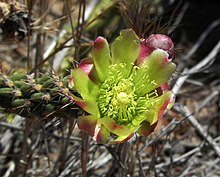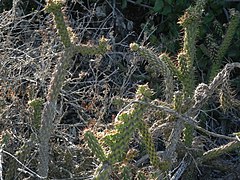
Cylindropuntia fulgida, the jumping cholla, also known as the hanging chain cholla, is a cholla cactus native to Sonora and the Southwestern United States.

Cylindropuntia bigelovii, the teddy-bear cholla(choy-ya), is a cholla cactus species native to Northwestern Mexico, and to the United States in California, Arizona, and Nevada.

Bergerocactus emoryi is a species of cactus, known commonly as the golden-spined cereus, golden snake cactus, velvet cactus or golden club cactus. It is a relatively small cactus, but it can form dense thickets or colonies, with the dense yellow spines giving off a velvety appearance when backlit by the sun. From April to May, yellow, green-tinged flowers emerge, which transform into reddish, globular fruit. This species is native to the California Floristic Province, and is found in northwestern Baja California and a small part of California, in San Diego County and on the southern Channel Islands. Where the Mediterranean climate of the California Floristic Province collides with the subtropical Sonoran Desert near El Rosario, hybrids with two other species of cacti are found. It is the sole member of the monotypic genus Bergerocactus, named after German botanist Alwin Berger.

Cylindropuntia imbricata, the cane cholla, is a cactus found in the Southwestern United States and northern Mexico, including some cooler regions in comparison to many other cacti. It occurs primarily in the arid regions of the Southwestern United States in the states of Kansas, Oklahoma, Texas, New Mexico, Arizona, Colorado, and Nevada. It is often conspicuous because of its shrubby or even tree-like size, its silhouette, and its long-lasting yellowish fruits.

Cylindropuntia is a genus of cacti, containing species commonly known as chollas, native to northern Mexico and the Southwestern United States. They are known for their barbed spines that tenaciously attach to skin, fur, and clothing. Stands of cholla are called cholla gardens. Individuals within these colonies often exhibit the same DNA, as they were formerly tubercles of an original plant.
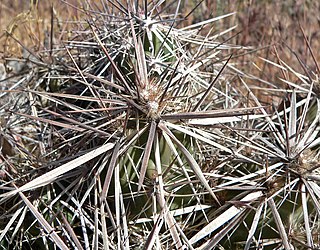
Corynopuntia, also known as club chollas, is a genus in the family Cactaceae, established by Knuth in 1935. Molecular phylogenetic studies suggest that it should be included in Grusonia, a view accepted by Plants of the World Online as of June 2021.

Agave shawii is a species of monocarpic succulent plant in the genus Agave, commonly known as Shaw's agave. It is a rosette-forming plant characterized by glossy, green leaves with toothed margins. After several years of slow growth, the plant puts all of its resources to produce a towering stalk of flowers, and then dies. The death of the flowering rosette is compensated by the growth of numerous clonal pups. This species is segregated into two subspecies, one native to the coast of southwestern California and northwestern Baja California, known commonly as the coast agave, and another native to the Baja California Desert, known as the Goldman agave.

Cuscuta californica is a species of dodder known by the common names chaparral dodder and California dodder. This is an annual parasitic plant that may resemble fine strands of spaghetti or twine strewn across other species in its habitat. A mature plant of this species may fulfill all of its food and water needs from the host plant, but they rarely kill their host. It is native to western United States and Baja California in Mexico.
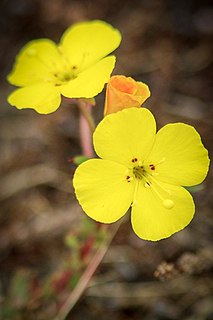
Camissoniopsis bistorta is a species of flowering plant in the evening primrose family known by the common names southern suncup and California suncup. It is native to southern California and Baja California, where it grows in several types of plant community along the coast and in the coastal hills and mountain ranges. This is a hairy annual or short-lived perennial herb spreading from a basal rosette, with stems reaching up to 80 centimeters long. The leaves are narrow and sometimes toothed, and 1 to 12 centimeters in length. Toward the end of the spreading stems are nodding inflorescences of flowers, each flower with four bright yellow petals dotted with red at their bases.

Opuntia basilaris, the beavertail cactus or beavertail pricklypear, is a cactus species found in the southwest United States. It occurs mostly in the Mojave, Anza-Borrego, and Colorado Deserts, as well as in the Colorado Plateau and northwest Mexico. It is also found throughout the Grand Canyon and Colorado River region as well as into southern Utah and Nevada, and in the western Arizona regions along the Lower Colorado River Valley.

Lonicera subspicata is a species of honeysuckle known by the common name southern honeysuckle. It is native to Baja California, California, and northern Baja California Sur, where it is known from several areas in mountain and coastal habitat, particularly chaparral. It is a vining shrub which usually climbs on other plants for support.

Cylindropuntia echinocarpa is a species of cactus known by the common names silver cholla, golden cholla, and Wiggins' cholla. It was formerly named Opuntia echinocarpa.

Opuntia littoralis is a species of prickly pear cactus known by the common name coastal pricklypear. It is sometimes called the sprawling prickly pear due to its short stems and habit of growing close to the ground. "Littoral" means "pertaining to the seashore".

Grusonia parishii is a species of cactus known by the common names matted cholla and Parish club cholla. It is native to the Mojave and Sonoran Deserts of California and Arizona.

Cylindropuntia ramosissima is a species of cactus known by the common names diamond cholla and branched pencil cholla.

Penstemon spectabilis is a species of penstemon known by the common name showy penstemon or showy beardtongue. It is native to southern California and Baja California, where it grows in the chaparral, scrub, and woodlands of the coastal mountain ranges.

Cylindropuntia leptocaulis, the desert Christmas cactus, desert Christmas cholla, pencil cactus, or tasajillo, is a species of cholla cactus.
Cylindropuntia abyssi, common name Peach Springs cholla, is a species of cactus endemic to northwestern Arizona. It is known from only from the Grand Canyon and in Peach Springs Canyon, on the Hualapai Reservation in Mohave County. It grows in desert scrub on limestone ledges and hilltops. The natural range of the species is fairly small, but it is locally abundant and growing in an isolated area with few threats to the species survival.

Cylindropuntia fosbergii is a species of cactus known by the common names Hoffmann's teddybear cholla, pink teddy-bear cholla, and Mason Valley cholla. It is endemic to south-eastern California where its range is restricted to the flats and hillsides of a very limited area in the region of Anza-Borrego Desert State Park in the western Sonoran Desert.
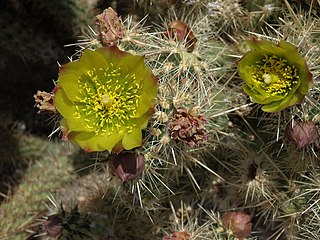
Cylindropuntia bernardina is a species of cholla cactus commonly known as the cane cholla or valley cholla, native to California and northwestern Baja California. It is an erect cholla that grows up to 2–3 meters tall, and occurs primarily in the foothills of the Transverse and Peninsular Ranges, parts of the Sonoran Desert, and in the Coast Ranges with a few populations around the Cuyama River. It was formerly placed as the variety parkeri of Cylindropuntia californica until it was renamed to C. bernardina. It is more closely related to Cylindropuntia ganderi than to C. californica.
